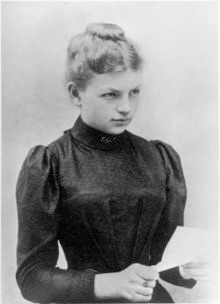Wroclaw, Poland




Clara Immerwahr
From Wikipedia, the free encyclopedia
Clara Immerwahr
Clara Immerwahr (1870–1915)
Born
June 21, 1870
Polkendorf near Breslau, Silesia Province, Kingdom of Prussia, today Poland
Died
May 2, 1915 (aged 44)
Residence
Nationality
Fields
Clara Immerwahr (June 21, 1870 – May 2, 1915) was a German chemist and the wife of fellow chemist Fritz Haber.
Early Life and Education
Clara Immerwahr was the youngest daughter of chemist Philipp Immerwahr and his wife Anna Krohn. Immerwahr studied at the University of Breslau, in 1900 attaining her degree and a Ph.D. in chemistry under Richard Abegg. Her dissertation was entitled Beiträge zur Löslichkeitsbestimmung schwerlöslicher Salze des Quecksilbers, Kupfers, Bleis, Cadmiums und Zinks (Contributions to the Solubility of the Slightly Soluble Salts of Mercury, Copper, Lead, Cadmium, and Zinc). She was the first woman Ph.D. at the University of Breslau [1] and received the designation magna cum laude. [2]
Marriage and work
Immerwahr married Haber in 1901. She was from a Jewish family, and had converted to Christianity in 1897.[3][4]
Due to societal expectations that a married woman's place was in the home, her ability to conduct research was limited. She instead contributed to her husband's work without recognition, translating his works into English. In 1902 she gave birth to Hermann Haber (1902–1946) the only child of that marriage.
Confiding in a friend, Immerwahr bemoaned her subservient role:
It has always been my attitude that a life has only been worth living if one has made full use of all one's abilities and tried to live out every kind of experience human life has to offer. It was under that impulse, among other things, that I decided to get married at that time... The life I got from it was very brief...and the main reasons for that was Fritz's oppressive way of putting himself first in our home and marriage, so that a less ruthlessly self-assertive personality was simply destroyed.[1][5]
During World War I, Haber became a staunch supporter of the German military effort and played an important role in the development of chemical weapons (particularly poison gases). His efforts would culminate in his supervision of the first successful deployment of what is nowadays considered as a weapon of mass destruction in military history, in Flanders, Belgium on April 22, 1915.
Death
Shortly after his return from Belgium, Immerwahr shot herself in the chest using Haber's military pistol. She died in her son's arms on 2 May. The morning after her death, Haber immediately left home to stage the first gas attack against the Russians on the Eastern Front.[6][7] Her suicide remained largely in the dark; it was never in the newspapers and there is no evidence of an autopsy. The undocumented nature of her death has led to much controversy as to her motives.
Fritz Haber eventually fled the Nazis in Germany and died in Basel, Switzerland in 1934. His and Clara's ashes were buried together in a cemetery in Basel.[5] Subsequently, their son Hermann Haber emigrated to the United States, where he committed suicide in 1946.[5] Ludwig ("Lutz") Fritz Haber (1921–2004), the son of Fritz Haber and his second wife, Charlotte, published a book on the history of poison gas, The Poisonous Cloud (1986).[8]




